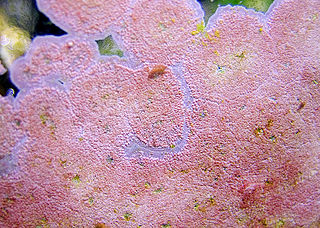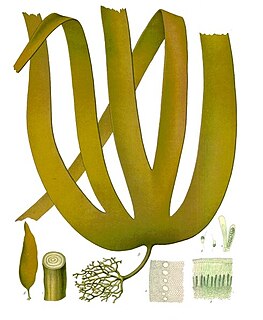
Algae is an informal term for a large and diverse group of photosynthetic eukaryotic organisms. It is a polyphyletic grouping that includes species from multiple distinct clades. Included organisms range from unicellular microalgae, such as Chlorella, Prototheca and the diatoms, to multicellular forms, such as the giant kelp, a large brown alga which may grow up to 50 metres (160 ft) in length. Most are aquatic and autotrophic and lack many of the distinct cell and tissue types, such as stomata, xylem and phloem, which are found in land plants. The largest and most complex marine algae are called seaweeds, while the most complex freshwater forms are the Charophyta, a division of green algae which includes, for example, Spirogyra and stoneworts.

Coralline algae are red algae in the order Corallinales. They are characterized by a thallus that is hard because of calcareous deposits contained within the cell walls. The colors of these algae are most typically pink, or some other shade of red, but some species can be purple, yellow, blue, white, or gray-green. Coralline algae play an important role in the ecology of coral reefs. Sea urchins, parrot fish, and limpets and chitons feed on coralline algae. In the temperate Mediterranean Sea, coralline algae are the main builders of a typical algal reef, the Coralligène ("coralligenous"). Many are typically encrusting and rock-like, found in marine waters all over the world. Only one species lives in freshwater. Unattached specimens may form relatively smooth compact balls to warty or fruticose thalli.

Laminaria is a genus of brown seaweed in the order Laminariales (kelp), comprising 31 species native to the north Atlantic and northern Pacific Oceans. This economically important genus is characterized by long, leathery laminae and relatively large size. Some species are called Devil's apron, due to their shape, or sea colander, due to the perforations present on the lamina. Others are referred to as tangle. Laminaria form a habitat for many fish and invertebrates.

Pelvetia canaliculata, the channelled wrack, is a very common brown alga (Phaeophyceae) found on the rocks of the upper shores of Europe. It is the only species remaining in the monotypic genus Pelvetia. In 1999, the other members of this genus were reclassified as Silvetia due to differences of oogonium structure and of nucleic acid sequences of the rDNA.

Corallina officinalis is a calcareous red seaweed which grows in the lower and mid-littoral zones on rocky shores.

Lottia gigantea, common name the owl limpet, is a species of sea snail, a true limpet, a marine gastropod mollusc in the family Lottiidae. Its genome has been sequenced at the Joint Genome Institute.

Patella ferruginea, commonly known as the ribbed Mediterranean limpet, is a species of sea snail, a true limpet, a marine gastropod mollusk in the family Patellidae, one of the families of true limpets. It is a large limpet, native to the western Mediterranean Sea, and although common in the past, it is now rare and restricted to only a few locations.

Scutellastra cochlear is a species of sea snail, a marine gastropod mollusc in the family Patellidae, one of the families of true limpets. It is commonly known as the snail patella, the pear limpet or the spoon limpet and is native to South Africa. It often grows in association with the crustose coralline alga Spongites yendoi and a filamentous red alga which it cultivates in a garden. It was first described by the malacologist Ignaz von Born in 1778 as Patella cochlear.

Scutellastra longicosta, the long-spined limpet or the duck's foot limpet, is a species of true limpet, a marine gastropod mollusk in the family Patellidae, one of the families of true limpets. It is native to the coasts of South Africa where it is found on the foreshore. It cultivates a species of crustose brown algae in a "garden".
Bangia is an extant genus of division Rhodophyta that grows in marine or freshwater habitats. Bangia has small thalli with rapid growth and high reproductive output, and exhibits behavior characteristic of r-selected species. The plants are attached by down-growing rhizoids, usually in dense purple-black to rust-colored clumps. The chloroplasts of Bangia, like others in the division Rhodophyta, contain chlorophyll a and sometimes chlorophyll d, as well as accessory pigments such as phycobilin pigments and xanthophylls. Depending on the relative proportions of these pigments and the light conditions, the overall color of the plant can range from green to red to purple to grey; however, the red pigment, phycoerythrin, is usually dominant.

Fucus distichus or rockweed is a species of brown alga in the family Fucaceae to be found in the intertidal zones of rocky seashores in the Northern Hemisphere, mostly in rock pools.

Desmarestia viridis is a species of brown algae found worldwide. Its common names include stringy acid kelp, green acid kelp, Desmarest's green weed, and sea sorrel, though the last name can refer to other species of Desmarestia. The light brown thallus is delicate with a disc-shaped holdfast. It releases sulfuric acid when damaged, destroying itself and nearby seaweeds in the process. They are found in shallow intertidal areas.
Lobophora variegata is a species of small thalloid brown alga which grows intertidally or in shallow water in tropical and warm temperate seas. It has three basic forms, being sometimes ruffled, sometimes reclining and sometimes encrusting, and each form is typically found in a different habitat. This seaweed occurs worldwide. It is the type species of the genus Lobophora, the type locality being the Antilles in the West Indies.

Spongites yendoi is a species of crustose red seaweed with a hard, calcareous skeleton in the family Corallinaceae. It is found on the lower shore as part of a diverse community in the southeastern Atlantic Ocean and the Indo-Pacific Ocean.

Ralfsiaceae is a family of brown algae in the order Ralfsiales.

Bonnemaisonia hamifera is a species of red alga in the family Bonnemaisoniaceae. Originally from the Pacific Ocean, it has been introduced into the northeastern Atlantic Ocean, where it is considered invasive on European coasts. It exists in two phases which, at one time, were thought to be different species; a medium-sized feathery form attached to other seaweeds, and a small tufted form known as Trailliella.

Soranthera ulvoidea, sometimes called the studded sea balloon, is a species of brown algae in the family Chordariaceae. It is the only species in the monotypic genus Soranthera. The generic name Soranthera is from the Greek soros (heap) and antheros (blooming). The specific epithet ulvoidea refers to certain resemblances the algae has with Ulva. The name in Japanese is 千島袋のり / ちしまふろくのり literally meaning "Kuril Islands bag nori".
Saccharina dentigera is a species of brown algae, in the family Laminariaceae. It is native to shallow water in the northeastern Pacific Ocean from the Gulf of Alaska to Baja California.

Hildenbrandia rubra is a marine species of thalloid red alga. It forms thin reddish crusts on rocks and pebbles in the intertidal zone and the shallow subtidal zone. It is a common species with a cosmopolitan distribution, and is able to tolerate a wide range of conditions.

Acinetospora crinita is a species of brown alga in the family Acinetosporaceae. It is found in the temperate northeastern Atlantic Ocean and the Mediterranean Sea.














